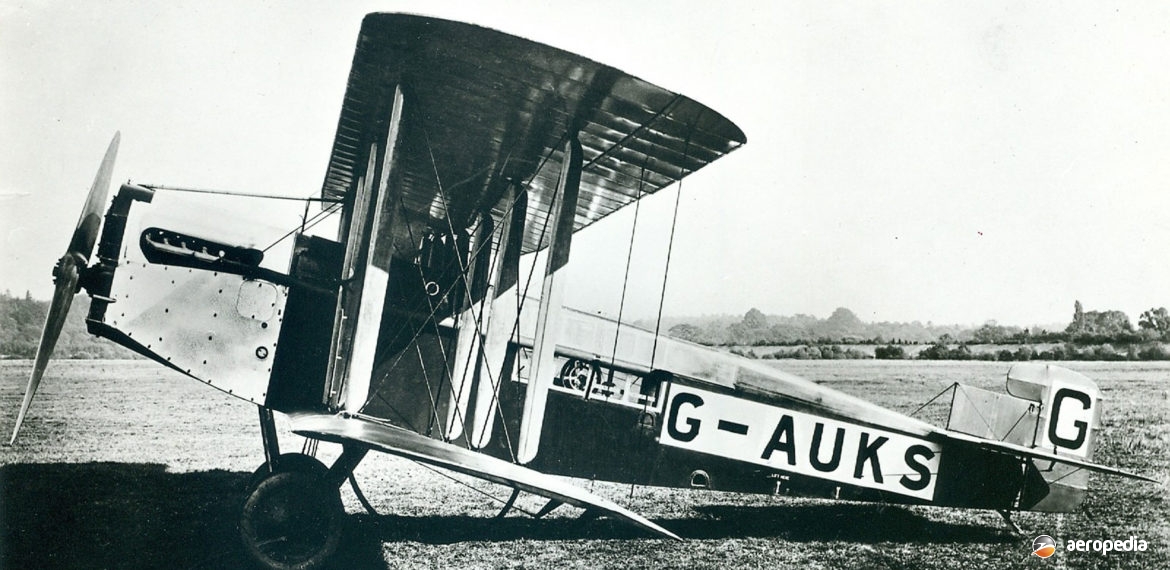Photograph:
Sopwith Wallaby G-EAKS marked as G-AUKS (c/n 3109) – which later became G-AUDU (Frank Walters collection)
Country of origin:
Great Britain
Description:
Two-seat long-range transport biplane
Power Plant:
One 280 kw (375 hp) Rolls Royce Eagle VIII twelve-cylinder VEE liquid-cooled engine
Specifications:
- Wingspan: 14.17 m (46 ft 6 in)
- Length: 9.60 m (31 ft 6 in)
- Max speed: 185 km/h (115 mph)
- Cruising speed: 172 km/h (107 mph)
- Empty weight: 1,261 kg (2,780 lb)
- Loaded weight: 2,359 kg (5,200 lb)
History:
The Wallaby, which was based on the Sopwith B.1 Bomber, was similar to the Sopwith Atlantic, which had been used by Harry Hawker in an unsuccessful trans-Atlantic attempt. Sopwith had designed the T.1 Cuckoo, a single-seat biplane with folding wings powered by a 149 kw (200 hp) Hispano Suiza engine, which was flown in 1917. This was a torpedo carrying landplane and orders had been placed for 350 aircraft but only 90 had been delivered at the time of the Armistice. The rest of the order was cancelled. It in fact entered service and a squadron was embarked on HMS Argus in October 1918 but did not see operational service.
At about the same time as the Wallaby was designed, two prototypes of the experimental B.1 bomber were built with the 149 kw (200 hp) Hispano Suiza engine. These aircraft were designed to carry a bomb-load of 254 kg (560 lb) but the type was not placed in production so only one saw any service over France.
The only Wallaby built (G-EAKS – c/n 3109) was first flown on 3 October 1919 and was fitted with a long-range fuel tank taken from Hawker’s aircraft. In 1919 two Australians, Captain George C Matthews and Sgt Thomas Kay, entered the Sopwith Wallaby in the competition for the first aircraft to fly from England to Australia (won by the Vickers Vimy G-EAOU). The rules, amongst other things, required the flight to be completed within 30 days of a start.
The Wallaby left Hounslow aerodrome near London on 21 October 1919. It crossed the English channel and landed at Marquise near Calais, France. Stops were made at Cologne in Germany, Mayence (later Mainz)valso in Germany, Vienna in Austria, and in Yugoslavia, where there was turmoil following World War I, and where the crew was imprisoned. After release the crew left and arrived in Istanbul in Turkey on 23 December but by that time the Vimy had reached Australia. On 4 January 1920 they crossed Syria to Baghdad in Iraq, and on to Karachi in Pakistan, running into severe sand storms on the way. They landed at Bandar Abbas in Persia (later Iran) but damaged the undercarriage and propeller in sand. The spare propeller, which was strapped to the fuselage side, was installed, the undercarriage was repaired, and they continued on to India. At Jask in Persia on 23 February they had more undercarriage problems.
During their time in Karachi they met up with Parer and McIntosh in the de Havilland DH.9, and the two aircraft proceeded to Calcutta. Sgt Thomas Kay became ill in Singapore and this delayed their departure until 7 April. On the flight from Singapore to Java, an island in Indonesia, further engine problems were suffered and later it was found a ball-race had disintegrated. Further repairs were effected and they continued on but at Grokgak near Singaraja on Bali on 17 April 1920 the engine lost power and a forced landing was made in a banana plantation, the machine being extensively damaged.
The flight had covered six months, although flying time for the 16,000 km (10,000 miles) from Hounslow had been 110 hours at an average speed of 160 km/h (100 mph). The crew later continued on to Sydney, NSW on the steamer SS Roggeveen, the damaged aircraft being conveyed in the hold of the vessel.
However the plans of Sopwith to develop a market in Australia failed and the Company placed itself in voluntary liquidation on 10 September 1920. In Melbourne, VIC a school hall in Washington Street, Essendon, VIC was employed as a workshop where the aircraft was rebuilt and registered on 30 August 1922 as G-AUDU (c/n 3109 – ex G-EAKS) to GC Matthews. On 11 November 1923 ownership was transferred to the Aircraft Supply Co of Melbourne.
On 3 June 1924 the Wallaby carried the first airmail from Adelaide to Sydney, landing at Mascot, in the hands of Lieut. F S Briggs. On board were A W Saunders as mechanic and a young Sydney mechanic C Arthur Butler, who later founded Butler Air Lines. The machine was named Bower Bird and was owned at that time by Australian Aerial Services Ltd. It was based at Hay, NSW for the services.
The Wallaby suffered more than its share of accidents. On one occasion it was being worked on in a hangar at Hay, when fuel leaked from the fuel gauges at night whilst maintenance was carried out under lighting and the aircraft burst into flames. It was dragged from the hangar and the fire put out but the aircraft was seriously damaged, requiring a complete rebuild. At this time a de Havilland DH.4 was put into service on the mail run whilst the work proceeded. The Wallaby was eventually written off after a forced landing 21 km (13 miles) west of Bowning, NSW on 13 October 1928.

